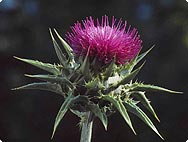
Silybum marianum (L.) GAERT
Milk Thistle

History
Sillybum is mentioned as a thistle-like medicinal plant as early as Pliny and in Dioscorides' Materia Medica. The name derives from the Greek sillybon or silybos, meaning ‘tassel’ or ‘tuft’. The species name marianum comes from the Latin and refers to a legend that the white spots on the leaves of this species of thistle came from the milk of the Virgin Mary nursing her child whilst fleeing to Egypt. Milk Thistle is a very old medicinal plant. In important medieval medical books such as Matthiolus' Book of Herbs of 1626, it is recommended ‘for side stitches which accompany jaundice’. In his Book of Herbs of 1679, Lonicerus writes that ‘it is good for an inflamed liver‘.

Botanichal characteristics
The Milk Thistle is an annual or biennial plant growing up to 1.5 metres in height. Its conspicuous, glossy green, white-veined, sinuate-lobed leaves are thornily toothed at the edges. Tufts of red-violet tubular flowers sit on the apically branching stalks in strongly bent-back, thorny husk leaves. The hard-shelled, light to dark brown, egg-shaped fruits (= achenes) bear silken, white, tufts of hair (= pappus, from the Greek pappos = grey-haired man) that fall off easily. Milk Thistle flowers from June to September. Milk Thistle was formerly classified in the family of the Dipsacacaea, genus Carduus. The more recent botanic system puts it in the Compositae family. The pharmaceutical nomenclature is often still based on the old name Carduus, which can lead to confusion.

Habitat
Milk Thistle originated in the Mediterranean region and is found from the Iberian Peninsula to Southern Russia, as well as in North Africa and Asia Minor. It has been introduced into North and South America and Southern Australia. It can sometimes be found growing wild in Central Europe. Milk Thistle prefers sunny, dry stone cliffs, the edges of paths, waste dumps, and pasture land.

Preparation
The herb itself and its dried seeds, released from the pappus, are used medicinally. The fruits are harvested in August or September, just before they are fully ripe. Once ripened, the seeds are threshed. A.Vogel/Bioforce produces a maceration from the whole fruits. This method ensures that the silymarin, in the shell of the fruit, is extracted without losing the fruit's fatty oil. Tea preparations from the whole fruits, which must infuse for at least 10 minutes, are rarely used. In France, the young leaves, unopened flower heads, and tap root are very popular as a delicacy.
A.Vogel Blog – Natural and Healthy
Inspiration for a healthy life!
HERBAMARE SOUP-ER SOUPS!
DOWNLOAD YOUR FREE RECIPE BOOKLET!
8 healthy, hearty and delicious homemade soups.
Supporting a healthier happier you
“Nature is just about the best thing we’ve got!“
Alfred Vogel's guide to leading a healthy and happy life
Healthy & nutritious dinner ideas
Get new recipes in your inbox every month. Sign up now